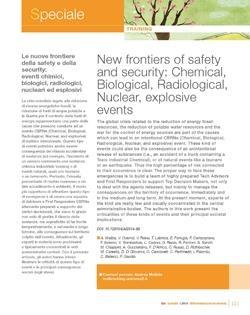
New frontiers of safety and security: Chemical, Biological, Radiological, Nuclear, explosive events
DOI: 10.12910/EAI2014-99
A. Malizia, V. Cusmai, V. Rossi, T. Labriola, E. Farrugia, F. Campopiano, F. Salerno, V. Trombadore, L. Cadoni, G. Rezza, R. Fantoni, S. Sandri, M. Chiappini, A. Gucciardino, F. D’Amico, C. Russo, D. Rothbacher, M. Carestia, D. Di Giovanni, O. Cenciarelli, C. Perrimezzi, I. Palombi, C. Bellecci, P. Gaudio
The global crisis related to the reduction of energy fossil resources, the reduction of potable water resources and the war for the control of energy sources are part of the causes which can lead to an intentional CBRNe (Chemical, Biological, Radiological, Nuclear, and explosive) event. These kind of events could also be the consequence of an unintentional release of substances (i.e., an accident of a truck containing a Toxic Industrial Chemical), or of natural events like a tsunami or an earthquake. Thus the high percentage of risk connected to their occurrence is clear. The proper way to face these emergencies is to build a team of highly prepared Tech Advisors and First Responders to support Top Decision Makers, not only to deal with the agents released, but mainly to manage the consequences on the territory of occurrence, immediately and in the medium and long term. At the present moment, experts of the kind are really few and usually concentrated in the central administrative bodies. The authors in this work present the criticalities of these kinds of events and their principal societal implications.
Le nuove frontiere della safety e della security: eventi chimici, biologici, radiologici, nucleari ed esplosivi
La crisi mondiale legata alla riduzione di risorse energetiche fossili, la riduzione di fonti di acqua potabile e la Guerra per il controllo delle fonti di energia rappresentano una parte delle cause che possono condurre ad un evento CBRNe (Chemical, Biological, Radiological, Nuclear, and explosive) di matrice intenzionale. Questo tipo di eventi potrebbe anche essere conseguenza del rilascio accidentale di sostanze (ad esempio, l’incidente di un camion contenente una sostanza chimica industriale tossica) o di eventi naturali, quali uno tsunami o un terremoto. Pertanto, l’elevata percentuale di rischio connesso a un tale accadimento è evidente. Il modo più opportuno di affrontare questo tipo di emergenze è di creare una squadra di Advisors e First Responders CBRNe altamente preparati a supporto dei vertici decisionali, che siano in grado non solo di gestire il rilascio delle sostanze, ma soprattutto di far fronte tempestivamente, e nel medio e lungo termine, alle conseguenze sul territorio colpito dall’evento. Attualmente, gli esperti in materia sono pochissimi e tipicamente concentrati in enti amministrativi centrali. Con il presente articolo, gli autori hanno inteso illustrare le criticità di questo tipo di eventi e le principali conseguenze sociali degli stessi
Andrea Malizia, Fabrizio D’Amico, Dieter Rothbacher, Mariachiara Carestia, Daniele Di Giovanni, Orlando Cenciarelli, Carlo Bellecci, Pasqualino Gaudio - University of Rome Tor Vergata, Industrial Engineering Department
Vittorio Cusmai - Italian Defence Staff, Division I
Vincenzo Rossi - Italian Ministry of the Interior
Tiziano Labriola - Italian Presidency of the Council of Ministers
Emanuele Farrugia - Italian Ministry for Foreign Affairs
Francesco Campopiano - Italian Presidency of the Council of Ministers, Civil Protection Dept.
Franco Salerno - Joint NBC Defence School
Vincenzo Trombadore - Italian Ministry of the Interior, Public Security Dept.
Luciano Cadoni - Italian Ministry of the Interior, Firefighters Dept.
Giovanni Rezza - ISS - Istituto Superiore di Sanità (Italian National Institute of Health)
Roberta Fantoni - ENEA, Technical Unit for the Development of Applications of Radiation
Sandro Sandri - ENEA, Radiation Protection Institute - Radiation Protection for Nuclear Fusion Plants and Large Accelerators Laboratory
Massimo Chiappini - Istituto Nazionale di Geofisica e Vulcanologia (INGV)
Antonio Gucciardino - University of Tor Vergata, Scientific Board of International Master Courses in Protection Against CBRNe events, Department of Industrial Engineering and School of Medicine and Surgery
Colomba Russo, Carlo Perrimezzi - Crati Scrl - Consorzio per la ricerca e le applicazioni di tecnologie innovative
Leonardo Palombi - University of Rome Tor Vergata, School of Medicine and Surgery - Department of Biomedicine and Prevention

